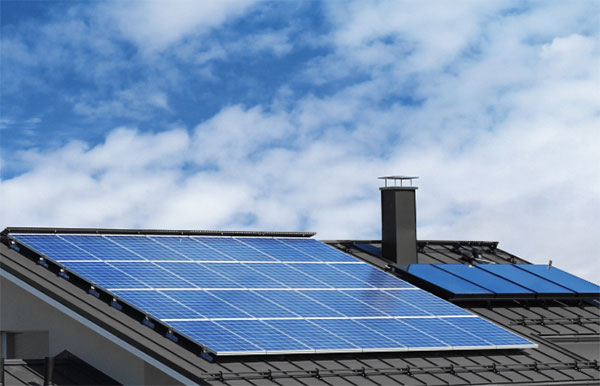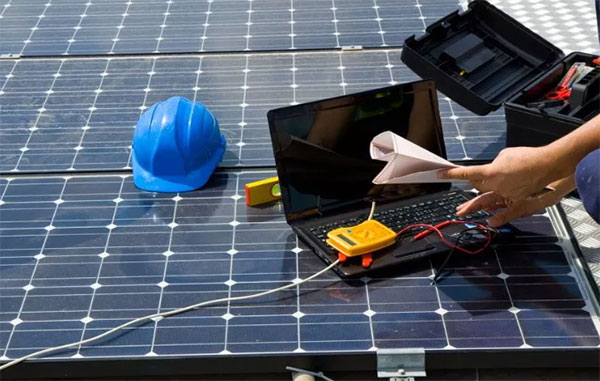Description
Solar panels can work in moonlight, but their efficiency is extremely low, making practical energy production negligible.
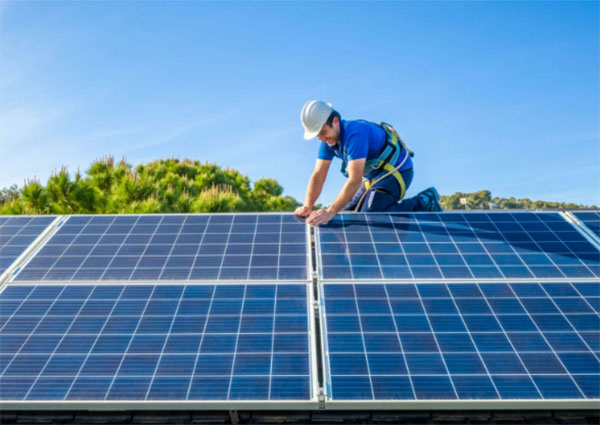
Do Solar Panels Work in Moonlight?
Solar panels are designed to convert sunlight into electrical energy. However, moonlight is also a form of light, albeit much weaker than sunlight. The fundamental question is whether the intensity of moonlight is sufficient to activate the photovoltaic cells in solar panels. Generally, solar panels can technically generate electricity from moonlight, but the efficiency is significantly lower compared to sunlight. The power output is drastically reduced due to the lower intensity of moonlight.
Understanding Solar Panel Technology
Solar panels consist of photovoltaic cells made from materials like silicon. These cells generate electricity by absorbing photons and creating an electric current. The efficiency of solar panels in converting light into electricity is a crucial factor, typically ranging from 15% to 20% for most commercial solar panels.
The Science Behind Solar Energy Absorption
Solar energy absorption involves photons striking the solar cells and knocking electrons free, creating a flow of electricity. Sunlight is composed of a broad spectrum of photons with varying energy levels, suitable for solar energy conversion.
Moonlight Characteristics and Solar Energy
Moonlight has a luminance of about 1 lux, whereas direct sunlight can exceed 100,000 lux. This vast difference in intensity means that the electricity generated by solar panels under moonlight is minimal. Furthermore, factors like the phase of the moon, atmospheric conditions, and panel orientation also influence the efficiency of solar panels in moonlight.
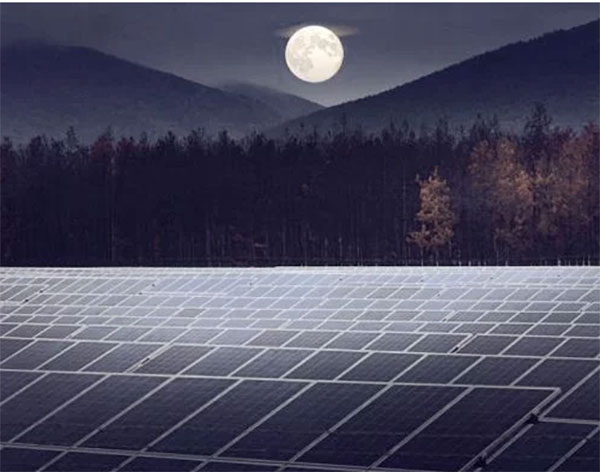
Comparative Analysis of Solar Energy Sources
In the realm of solar energy, understanding the effectiveness of solar panels under various light sources is critical. This section delves into a detailed comparative analysis, focusing on the differences between sunlight and moonlight from a photovoltaic perspective, and the efficiency of solar panels under these differing conditions.
Sunlight vs. Moonlight: A Photovoltaic Perspective
| Factor |
Sunlight |
Moonlight |
| Intensity (Lux) |
32,000-100,000 |
About 1 |
| Power Output |
Average 150-200 Watts/m2 |
Negligible (milliwatts range) |
| Efficiency |
15-20% (Commercial Panels) |
Extremely Low (Not practical) |
| Cost-Effectiveness |
High |
Negligible |
| Application |
Wide range, from residential to industrial |
Limited to experimental or low-power devices |
| Material Suitability |
Broad range (e.g., Silicon, Thin-film) |
Requires high-sensitivity materials |
| Durability and Lifespan |
25-30 years |
Not a significant factor due to low power output |
| Advantages |
Reliable, sustainable, scalable |
Minimal ecological impact |
| Limitations |
Weather dependent, requires daylight |
Insufficient for practical energy production |
Efficiency of Solar Panels Under Different Light Sources
When comparing the efficiency of solar panels under different light sources, it is evident that sunlight reigns supreme. The efficiency of a solar panel is primarily determined by the intensity and quality of light it receives. Under sunlight, the high intensity results in substantial electron activity within the photovoltaic cells, leading to higher energy production. In contrast, moonlight, being a reflected and much weaker source of light, does not provide enough energy to significantly excite the electrons in the solar cells. This results in an exceedingly low power output, rendering it impractical for standard solar energy applications.

Factors Influencing Solar Panel Performance in Moonlight
The performance of solar panels in moonlight is influenced by various factors, including the sensitivity of photovoltaic cells to light intensity, the phases of the moon, and environmental and atmospheric conditions. Each of these factors plays a critical role in determining the extent to which solar panels can harness moonlight effectively.
Photovoltaic Cell Sensitivity to Light Intensity
- Cell Composition: Solar cells made of materials like monocrystalline silicon or polycrystalline silicon are optimized for sunlight and have limited sensitivity to low light levels.
- Response to Low Light: In moonlight, the energy output is significantly lower due to the reduced intensity. For instance, a panel that produces 200 Watts in full sunlight might only produce milliwatts under moonlight.
- Technological Advances: Research is ongoing to develop cells with higher sensitivity to low-light conditions, potentially improving efficiency in moonlight.
Impact of Moon Phases on Solar Energy Harvesting
- Full Moon vs. New Moon: During a full moon, the intensity of moonlight is at its peak, offering the best (though still limited) conditions for solar energy harvesting. In contrast, a new moon provides almost no moonlight.
- Variation in Light Intensity: The light intensity can vary between 0.1-1 lux depending on the moon's phase, impacting the photovoltaic output.
- Optimal Conditions: Even under the best conditions (a full moon), the power output remains a fraction of what is achievable with direct sunlight.
Environmental and Atmospheric Conditions
- Weather Impact: Cloud cover, atmospheric dust, and pollution can further reduce the already low intensity of moonlight reaching the solar panels.
- Temperature Effects: Cooler temperatures during the night can improve solar cell efficiency, but this improvement is negligible due to the low light intensity of moonlight.
- Geographical Variations: The geographical location and the angle of the moon's light can also affect the performance of solar panels at night.
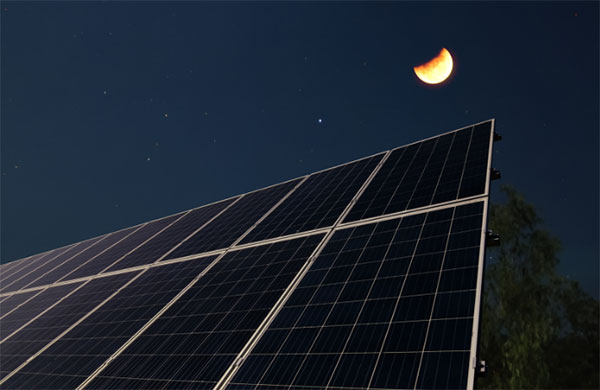
Real-World Applications and Limitations
Exploring the real-world applications and limitations of using solar panels at night and their performance in low light conditions reveals the practicality and challenges of solar energy in these scenarios.
Practicality of Using Solar Panels at Night
- Limited Energy Production: Even the most efficient solar panels produce minimal energy at night. For instance, a standard solar panel that generates 250 Watts in daylight might produce only about 1-3 Watts under full moonlight.
- Energy Storage Solutions: To utilize solar energy at night, energy storage systems like batteries are essential. However, the cost and efficiency of these systems vary.
- Potential Applications:
- Low-power applications, such as LED lighting or sensors, can sometimes be powered by solar panels at night, albeit inefficiently.
- Experimentation in areas with high moonlight intensity or prolonged twilight hours.
Case Studies: Solar Panel Performance in Low Light Conditions
- Experimental Solar Farms:
- Location: High-altitude areas where moonlight is more intense.
- Findings: Slight increases in power output during full moon conditions, but not enough to justify the costs for large-scale energy production.
- Efficiency: Marginal improvements in efficiency with advanced photovoltaic technology.
- Urban Solar Installations:
- Setting: City environments with ambient light pollution.
- Observations: Slightly higher energy production at night compared to rural areas due to reflected light from surroundings.
- Limitations: Still not sufficient for practical energy needs without storage systems.
- Portable Solar Devices:
- Products: Solar-powered chargers, lights, and small gadgets.
- Performance: Capable of storing energy during the day for night-time use. Direct energy production at night remains minimal.
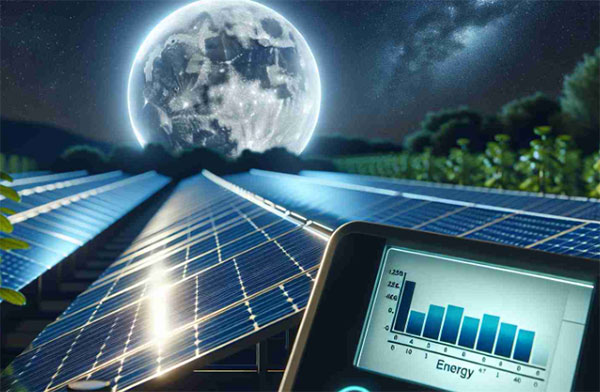
Technological Enhancements for Low Light Energy Harvesting
Advancements in technology are crucial for improving the efficiency of solar panels, especially in low light conditions like moonlight. These enhancements focus on optimizing photovoltaic cell design and developing new technologies to maximize solar energy efficiency.
Innovations in Photovoltaic Cell Design
- Multi-Junction Cells: Designed to capture different wavelengths of light, increasing efficiency in varying light conditions.
- Thin-Film Technology: Offers better performance in low light compared to traditional silicon cells.
- Quantum Dot Solar Cells: Utilize nano-sized semiconductors that can potentially absorb more light across the solar spectrum.
- Bi-Facial Solar Panels: Capable of capturing reflected light from the surroundings, thus improving overall efficiency.
Emerging Technologies in Solar Energy Efficiency
- Concentrated Photovoltaic Cells (CPV): Utilize lenses or mirrors to concentrate sunlight onto high-efficiency solar cells.
- Perovskite Solar Cells: Show promise for higher efficiency and lower production costs, potentially improving performance in low-light conditions.
- Organic Photovoltaic Cells: Flexible and can be produced at lower costs, offering potential for different applications where traditional panels are not viable.
- Smart Solar Panels: Equipped with sensors and algorithms to adjust to light conditions and maximize energy absorption.







